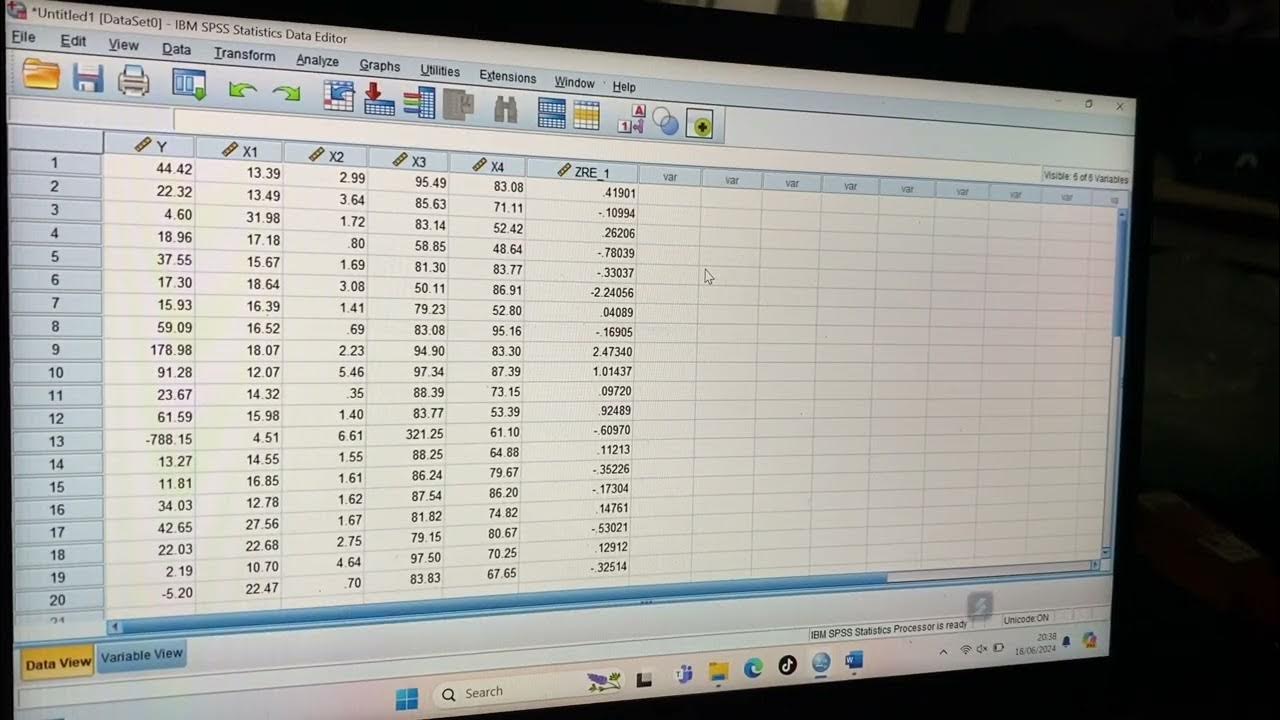UJI NORMALITAS (KOLMOGOROV-SMIRNOV) secara manual #statistika
Summary
TLDRIn this video, the presenter explains the step-by-step process of conducting a Kolmogorov-Smirnov (K-S) normality test manually. The tutorial begins with hypothesis formulation and data organization, followed by calculating cumulative frequencies and proportions, and normalizing the data. The video also covers the use of Z-tables to determine the area under the normal curve, as well as the Kolmogorov-Smirnov test statistics and their comparison to critical values from a table. The video concludes with a practical example of testing a dataset, helping viewers understand how to assess if data follows a normal distribution.
Takeaways
- 😀 The Kolmogorov-Smirnov normality test is used to determine if a dataset follows a normal distribution.
- 😀 The first step is to form hypotheses: H0 (data is normally distributed) and Ha (data is not normally distributed).
- 😀 Data should be organized in ascending order and frequencies for each value should be determined.
- 😀 Cumulative frequencies and cumulative proportions must be calculated for each data point.
- 😀 The Z-value for each data point is calculated using the formula Z = (X - X̄) / SD, where X̄ is the mean and SD is the standard deviation.
- 😀 Use a Z-table to find the area under the normal curve corresponding to each Z-value.
- 😀 Both negative and positive Z-values are handled by using their positive equivalent for finding the area under the normal curve.
- 😀 The Kolmogorov-Smirnov calculation involves finding the maximum difference between observed cumulative proportions and expected cumulative proportions.
- 😀 The calculated Kolmogorov-Smirnov value (A1 or A2) is compared with the critical Kolmogorov-Smirnov table value.
- 😀 If the calculated Kolmogorov-Smirnov value is greater than the table value, H0 is rejected (data is not normally distributed).
- 😀 If the calculated Kolmogorov-Smirnov value is smaller than the table value, H0 is accepted (data is normally distributed).
Q & A
What is the purpose of the Kolmogorov-Smirnov normality test?
-The Kolmogorov-Smirnov normality test is used to determine whether a given data set follows a normal distribution. It compares the empirical distribution function of the data with the cumulative distribution function of a normal distribution.
What are the first steps in performing a Kolmogorov-Smirnov normality test?
-The first steps include forming hypotheses and organizing the data. The data should be arranged from the smallest to the largest values, and then the frequencies for each value are determined.
What does the cumulative frequency represent in the Kolmogorov-Smirnov test?
-The cumulative frequency represents the cumulative sum of the frequencies for each data point, starting from the first value and continuing to the last value.
How do you calculate the cumulative proportion for each data point?
-The cumulative proportion is calculated by dividing the cumulative frequency (F) for each data point by the total number of data points (n).
How is the Z-score calculated in the Kolmogorov-Smirnov test?
-The Z-score is calculated using the formula Z = (X - X̄) / SD, where X is the data point, X̄ is the mean of the data, and SD is the standard deviation of the data.
What is the purpose of using the Z-table in the Kolmogorov-Smirnov normality test?
-The Z-table is used to determine the area under the standard normal curve corresponding to the calculated Z-scores. This helps in calculating the cumulative proportion for each data point.
What do A1 and A2 represent in the Kolmogorov-Smirnov test?
-A1 and A2 represent the Kolmogorov-Smirnov test statistics for the lower and upper bounds, respectively. A1 is calculated for the lower boundary and A2 for the upper boundary, based on the cumulative frequencies and Z-scores.
How are A1 and A2 calculated?
-A1 is calculated by taking the absolute difference between the cumulative proportion and the Z-score at the lower boundary. A2 is similarly calculated for the upper boundary.
How is the Kolmogorov-Smirnov critical value determined?
-The critical value is determined from the Kolmogorov-Smirnov table, which provides the critical values for various sample sizes (n) and significance levels (α). For a sample size of 40 and α = 0.05, the critical value is 0.215.
What is the conclusion drawn from the Kolmogorov-Smirnov test?
-If the calculated Kolmogorov-Smirnov statistic is greater than the critical value from the table, the null hypothesis (that the data is normally distributed) is rejected. Otherwise, if the calculated value is smaller, the null hypothesis is accepted, indicating that the data is normally distributed.
Outlines

This section is available to paid users only. Please upgrade to access this part.
Upgrade NowMindmap

This section is available to paid users only. Please upgrade to access this part.
Upgrade NowKeywords

This section is available to paid users only. Please upgrade to access this part.
Upgrade NowHighlights

This section is available to paid users only. Please upgrade to access this part.
Upgrade NowTranscripts

This section is available to paid users only. Please upgrade to access this part.
Upgrade NowBrowse More Related Video

Tutorial Menggunakan Spss untuk data Panel

Tutorial SPSS Uji Asumsi Klasik : Uji Normalitas, Uji Multikolinearitas dan Uji Heteroskedastisitas

Cara Uji Normalitas dan Homogenitas Menggunakan SPSS dengan Mudah

Uji Normalitas Shapiro Wilk Dengan SPSS

#2- UJI NORMALITAS DATA KELAS EKSPERIMEN DAN KELAS KONTROL MENGGUNAKAN SPSS

Uji Normalitas Menggunakan SPSS
5.0 / 5 (0 votes)